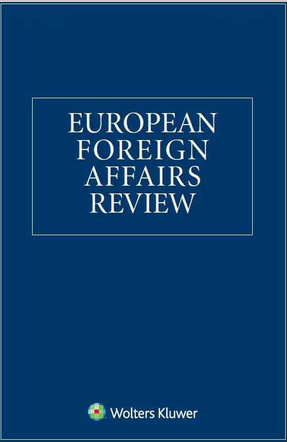Research
Project publications
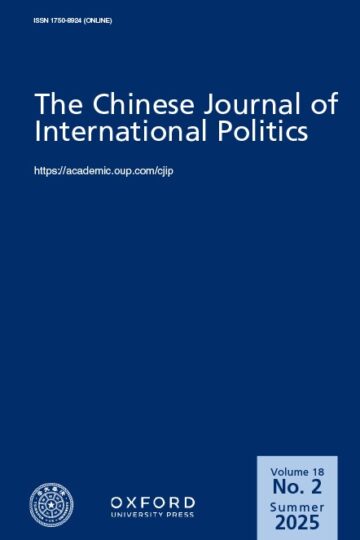 Breslin, Shaun and Mikael Mattlin (2025) “Bundling Threats: Why Dominant Perceptions of China Changed in Europe”. The Chinese Journal of International Politics, (18) 2: 196–219.
Breslin, Shaun and Mikael Mattlin (2025) “Bundling Threats: Why Dominant Perceptions of China Changed in Europe”. The Chinese Journal of International Politics, (18) 2: 196–219.
Popular perceptions of China in Europe have clearly shifted over the past few years. This article builds on the literature that assesses how narratives of China emerge and change, and how they influence policy on how best to respond to China’s rise. We construct an analytical framework in which we identify two different types of reasons for change in dominant perceptions, underlying and precipitating, and a transmitting process (narrative diffusion). We argue that four underlying and three precipitating reasons together with active diffusion of a particular academic and policy narrative explain why dominant perceptions of China changed in Europe to predominantly negative within a relatively short time period. We explore what foundational assumptions this dominant narrative depends on, and what is considered as evidence (and evidence of what). We suggest that a projected threatening future image of China explains how current actions of Chinese actors are interpreted and that this interpretation in turn reinforces the projected future image in a circular logic, with clear policy implications. The associated assumptions, conflations, evaluation, and beliefs regarding ability and agency bundle together many different concerns that analytically should be kept separate. This leads to difficulties in discerning between diverse kinds of risks and threats on different timescales, with policymakers often opting for playing safe.
Breslin, Shaun, Liisa Kauppila and Elina Sinkkonen (2024) “Is De-Risking Possible? Responding to China-Relation Economic Insecurities”. Eurohub4Sino Policy Paper, 9th April 2024.
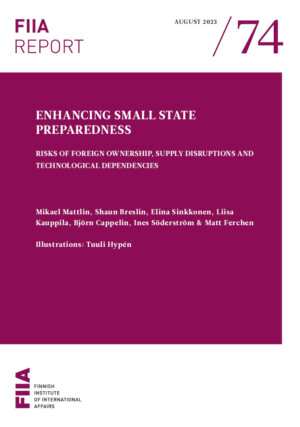 Mattlin, Mikael, Shaun Breslin, Elina Sinkkonen, Liisa Kauppila, Björn Cappelin, Ines Söderström and Matt Ferchen (2023) Enhancing small state preparedness: Risks of foreign ownership, supply disruptions and technological dependencies. FIIA Report 74.
Mattlin, Mikael, Shaun Breslin, Elina Sinkkonen, Liisa Kauppila, Björn Cappelin, Ines Söderström and Matt Ferchen (2023) Enhancing small state preparedness: Risks of foreign ownership, supply disruptions and technological dependencies. FIIA Report 74.
The post-Cold War liberalist view, according to which interdependences supported a virtuous cycle of mutual gains, has given way to a realist-tinged view that regards economic interdependence as a cause of insecurity and an element in conflicts. In this new environment of increasing great power competition and technological decoupling, all states are not created equal. Major states such as the United States and China can be system shapers, whereas small states tend to be system takers. Unlike smaller states, they have a greater ability to use their investment leverage, supply chain dominance and control of core technologies. For smaller states with open economies, such as Finland and Sweden, these capabilities of major powers create vulnerabilities in the form of security risks of foreign ownership, supply disruptions and critical technological dependencies.
The report explores how small states can mitigate such risks. A series of innovative Delphi backcasting exercises in Finland and Sweden brought together 113 sectoral experts and generalists to ponder ways to prevent dystopian scenarios from unfolding. The target years of the scenarios extended from 2027 to 2035, encouraging ideas on both short- and longer-term solutions. Instead of aiming for a consensus of expert views, the process sought to produce a variety of effective means and measures that a small state could choose to adopt.
The exercise consisted of nine scenarios, presented as comic art. The narratives on the risks of foreign ownership focused on 1) acquisitions of gaming companies gathering personal data, 2) transfers of real estate ownership in Lapland and 3) venture capital investments in emerging technology start-ups. The scenarios on supply disruptions dealt with 4) discriminatory practices limiting access to antibiotics, 5) political retaliation limiting access to water treatment components and 6) sanctions on wind power materials, components and minerals. As for high technology dependencies, the cases included 7) the maintenance of military technology, 8) the cybersecurity of health technology and 9) the supply of chemicals for research and development activities.
According to the report, small states have the least leeway in navigating the risk environments created by technological dependencies, whereas the toolkits to tackle the potential dangers of foreign ownership and supply disruptions are more extensive. Although different issues and insecurities require different bespoke solutions, all the risk categories call for active mitigation efforts. Most of the suggested Finnish and Swedish expert solutions can be clustered into three alternative approaches: protectionist/interventionist, liberal and technologically oriented.
Protectionist/interventionist solutions would expand the state’s powers in controlling, guiding and limiting economic activities. Key suggestions included:
- covering acquisitions and greenfield investments in national foreign direct investment screening
- screening real estate acquisitions with a wide range of countries of origin
- imposing country-specific limitations to real estate acquisitions
- screening venture capital investments in emerging technologies
- initiating a national security act to limit foreign control rapidly
- imposing country- and company-specific limitations to bids in critical industries
- increasing tariffs
- supporting domestic or EU-level production through subsidies and industrial policy
- friendshoring the production of critical goods
- expanding the scope of supply stockpiling in pharmaceuticals and water treatment components
The more liberal approach towards national preparedness would focus on solving the challenges primarily through carrots instead of sticks – to avoid limiting entrepreneurial freedoms and interfering with the dynamics of the capitalist market economy. The proposed solutions included:
- initiating value debates to guide individuals’ choices when accepting investments
- formulating a national innovation strategy to boost domestic companies’ operating conditions in emerging technology fields
- teaching “technology literacy” to guide the use of foreign-owned products
- engaging all stakeholders in making decisions on foreign ownership
- diversifying the sources of critical goods such as antibiotics
- enhancing awareness of risks and making “plan Bs” in supply chain management
- deepening the EU’s single market to offer genuine scalability opportunities for start-ups
The third, more technologically oriented approach would rely on new innovations or technical solutions to enhance small state preparedness. Key ideas included:
- innovating new medicines to replace antibiotics
- prioritising non-conventional technologies such as small modular reactors (SMRs)
- enhancing domestic capacity to produce key components with 3D printing
- researching alternative materials to replace critical chemicals
- developing the recycling, recovery and transportation of critical chemicals
- adopting geofencing and coding solutions to enhance cybersecurity
- designating emerging technologies as focus areas in higher education
- increasing the adaptability of technical solutions through standardisation
These three approaches prioritise different key solutions for enhancing small state preparedness. However, they represent generic policy preferences rather than ready-made policy recommendations. Ideally, states can formulate their own pick-and-mix toolkit by combining elements from the different approaches. The complementary nature of some of the suggested expert views was also suggested by the fact that many – even most – respondents argued for diversification as a solution to various challenges. For example, and regardless of the chosen strategy, tendering rules could be improved by placing quality over price, taking geopolitical risks into account and allowing multiple winners in contrast to the currently dominant winner-takes-it-all logic, which leads to overly concentrated supply chains. Moreover, at least minor legislative tightenings were widely proposed to be made on foreign ownership – especially with regard to that of nationals of authoritarian states. These changes were, however, typically proposed to be complemented with such balancing acts as long-term leases and incentives to develop and acquire domestic products and companies.
Ultimately, by highlighting alternative approaches to small state preparedness, this report seeks to encourage democratic discussion on a broader political choice: what type of state and economy do we want in the future? It is not only their identity that guides what states do; adopted policies and means also shape state identities over time.
(2023) “Five modes of China’s economic influence: rethinking Chinese economic statecraft“. The Pacific Review.
Interest and anxiety about China’s economic statecraft, or the ways in which it uses economic means to achieve foreign policy, is booming. The overriding perception is that China has sophisticated, long-term plans to enhance its power on the global stage through the use of economic strategies and tools and that it is uniquely capable of effectively implementing those plans now or in the future. Yet when it comes to actual outcomes, whether or not China has been able to achieve its foreign policy goals via economic means, the evidence is mixed at best. This article seeks to move beyond some of the shortcomings in our understanding of Chinese economic statecraft by exploring the links between perceptions, ambitions, abilities, and outcomes of Chinese foreign economic policies and behaviour. We propose an alternative to the concept of economic statecraft by introducing instead five different ‘modes of economic influence’. We suggest directions for future research focused on China’s economic influence, including its latent structural power.
(2023) “Economic statecraft, geoeconomics and regional political economies“. The Pacific Review.
In this introduction to the special issue, we establish the overarching objective for the collection; to investigate the salience and efficacy of conceptions of Economic Statecraft (ES) and Geoeconomics for understanding and explaining shifts in state-market relationships in a number of regional political economies. After a very short overview of different generations of ES research, we establish the set of common questions that each of the papers address, and how we arrived at them as the research project evolved. We point to the importance of ensuring that ES is not just thought of as something that the more powerful regional states engage in, and the need to adopt a three-part analytical distinction between different components of ES: motivations and objectives; actions and tools; and outcomes and consequences. This allows us to trace the relationship between goals and effects, provides a basis for comparative studies, and makes it easier to make a distinction between ES and other forms of state involvement in the economy.
Mattlin, Mikael and Mikko Rajavuori (2023) “Changing Causal Narratives and Risk Perceptions on Foreign Investment: the Riskification of Chinese Investments in the Nordic Region“. East Asia.
This article surveys recent legislative and policy changes on foreign investments in four Nordic countries (Finland, Sweden, Denmark and Norway). Until recently, only Finland had national legislation on foreign investments, although historically the Nordic countries were forerunners in introducing foreign investment controls. A general rethink in the USA and the European Union on the links between liberal economies, investment policies and security has occurred in recent years. This has cast investments by enterprises from major authoritarian countries, foremost China, in a different light. Rather than investment numbers as such, or realised risks related to Chinese investments, a ‘causal narrative’ has emerged in the Nordic countries that draws attention to the nature of the Chinese party-state and its’ unclear relationship to Chinese companies, underlining potential strategic motivations and security risks behind Chinese investments. Rapidly changing risk perceptions have driven legislative and policy changes on foreign direct investment (FDI), e.g. investment screening. Chinese investments have thus become riskified, to use a term coined by Olaf Corry. Shifting risk perceptions have similarly preceded previous ‘formative epochs’ in Nordic FDI legislation in the early twentieth century, after the Second World War and at the end of the Cold War. Each formative epoch has been characterised by a distinctive ‘risk profile’. We postulate that these shifting risk perceptions significantly shape the reception of FDI as a key channel of cross-border connectivity.
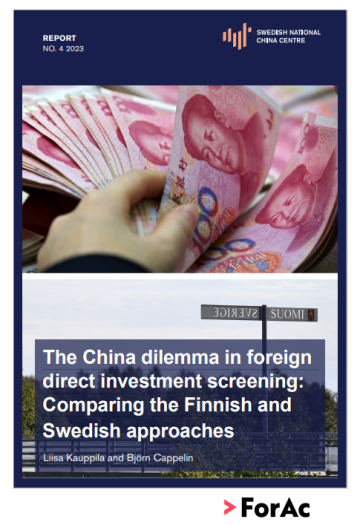
Kauppila, Liisa and Björn Cappelin (2023) “The China dilemma in foreign direct investment screening: Comparing the Finnish and Swedish approaches“. NKK report, 20 June.
The report examines the trends and challenges related to Chinese foreign direct investment (FDI) in Finland and Sweden, two prominent recipients of Chinese FDI in the European Union. The report highlights the amendments made to FDI controls in Finland and the upcoming changes in Sweden’s screening mechanism, both influenced by the introduction of the EU’s FDI screening framework. The study explores how to mitigate the risks of Chinese FDI while ensuring that desirable investments continue to be attracted in the future. It delves into the focus areas of each country, with Finland prioritizing supply security and Sweden considering broader national security concerns and investor intentions. While the security risks associated with Chinese investments are recognized, the positive contributions to economic development are also acknowledged.
Kauppila, Liisa and Sanna Kopra (2022) ”China’s rise and the Arctic region up
to 2049 – three scenarios for regional futures in an era of climate change and power transition”. The Polar Journal 12(1): 148-171.
Although China has emerged as an increasingly influential global actor over recent decades, it is unclear whether a more fundamental transformation is shaking processes of regionalisation in this context. Our scenario-based case study considers the spatial reconfiguration of the rapidly globalising Arctic with varying degrees of Chinese engagement. More specifically, we examine alternative and transformational configurations of the Arctic in 2049, and ponder upon the plausibility of the hypothesised changes in light of three schools of thought on International Relations – realism, liberal institutionalism and relationalism. Hence, we explore how the rise of China could potentially alter the regional dynamics and whether, consequently, regions should be rethought both empirically and theoretically. We conclude that pluralistic discussion on the multiple regional outcomes is a necessary precondition for achieving a balanced and democratic future in the Arctic and beyond.
Poutala, Tero, Elina Sinkkonen and Mikael Mattlin (2022) “EU Strategic Autonomy and the Perceived Challenge of China: Can Critical Hubs Be De-weaponized?“, European Foreign Affairs Review 27, Special Issue: 79 – 98.
Geoeconomic competition, supply security vulnerabilities and complex technological dependencies challenge the European Union’s ‘strategic autonomy’. Evolving from more traditional security/ defence notions, a broader definition of strategic autonomy encompasses also economic dimensions. Economic resilience underpins security and defence arrangements. The EU has lacked instruments for protection against ‘predatory’ strategic investments by external actors, and technological dependence on potential strategic rivals. This article analyses two critical hubs, or potential ‘chokepoints’, in the EU’s attempts to achieve strategic autonomy – critical maritime transport infrastructure and 5G – as well as countermeasures developed by the EU. Chinese enterprises have made strategic investments in key EU infrastructure and high-tech industries over the past decade. In response, the EU has established an investment screening framework to screen (authorize, issue condition, prohibit or unwind) inward foreign direct investment (FDI) on security or public order grounds, and activated a mechanism for the enhancement of coordination and cooperation between the Commission and Member States. The EU has also sought to reduce reliance on Chinese suppliers by introducing the ‘5G toolbox’. We argue that the EU aims to ‘de-weaponize’ these two potential chokepoints. However, our article concludes that the political goal of strategic autonomy vis-à-vis external actors is hampered by the competence limitations of the Union to act in critical areas. Ultimately, much of the heavy lifting on implementing EU policy goals still falls upon Members States with varied economic and security interests.
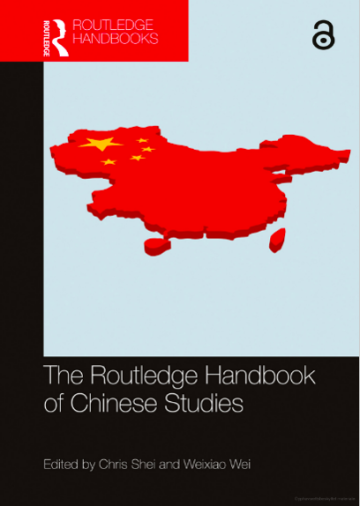
Mattlin, Mikael (2021) “Normative economic statecraft: China’s quest to shape the world in its image,” in Chris C. Shei and Weixiao Wei (eds) Routledge Handbook of Chinese Studies. London: Routledge.
Arguably, two of the greatest questions in 21st-century world politics are how the preexisting institutions of the international system will be able to accommodate a rapidly rising China, and how China is going to wield its expanding global power and influence. Unsurprisingly, these have also been two of the hottest topics in Chinese studies over the past decade. Until the global financial crisis in 2008 and the Chinese leadership change in 2012, China was commonly seen as a nonrevisionist power gradually integrating into the Pax Americana system, while securing its own national interests. Since then, views of China’s rise have undergone a transformation. Today, China’s actions on the global stage invite more wary commentary, even apprehension. Yet, compared both to former and current Great Powers, what stands out about China’s use of power and influence is neither its militarism nor its ‘soft power’. China wields its power most actively, and arguably also most effectively, by using the purse, i.e., through trade, investment, and lending. China’s signature foreign policy project, the Belt and Road Initiative (BRI), is a case in point. This chapter provides an overview of state-of-the-art research revolving around China’s use of economic and financial means to serve foreign policy objectives with normative implications, defined here as normative economic statecraft. The chapter’s overview of China’s use of economic statecraft reveals its breadth and diversity. China also indirectly challenges existing international norms of economic governance by its alternative modus operandi. As China does not always proclaim its challenge to existing norms, this paper suggests an analytical distinction between stated and concealed normative objectives. Much of China’s challenge to global economic governance norms is concealed. Research on China has revitalized old debates on economic statecraft and geoeconomics, and reoriented their focus from economic coercion (e.g., sanctions) to economic inducements, and alternative institutions and norms. This subfield of China studies thus has a scholarly impact beyond the area studies specialization.
Other relevant publications by the core research team (2020-2023)
Breslin, Shaun (forthcoming 2025).“Where Does Discourse Take Us? Perceptions of the State(craft) in UK-China Relations”, in Ágota Révész, Duncan Freeman and Magnus Feldmann (eds) Narrating China and Europe in Uncertain Times. Bristol, Bristol University Press.
Breslin, Shaun and Peter Burnham (2023) “International Order Transition and the UK’s Tilt to the `Indo-Pacific’”, The Pacific Review, 36 (2), 2023: 406-432.
Breslin, Shaun (2023) “L’Economic Statecraft della Cina: Un attorre illiberale in un’economia globale (piu) liberale” in Giuseppe Gabusi (ed) L’Asia Al Centro Del Cambiamento: Politica, economia, sicurezza: 39-48.Rome: Treccani.
Breslin, Shaun (2023) “Do we need a new vocabulary for talking about European strategy?”, in Michiel Foulon and Jack Thompson (eds) The Future of European Strategy in a Changing Geopolitical Environment: Challenges and Prospect. Zurich: ETH Center for Security Studies.
Breslin, Shaun (2021) “Chinese Economic Statecraft. An Illiberal Actor in a (more) Liberal Global Economy: Who is Changing Who?”, in Giuseppe Gabusi (ed) Drivers of Global Change: Responding to East Asian Economic and Institutional Innovation: 5-9. Torino: T-Wai.
Breslin, Shaun (2021) China Risen? Studying Chinese Global Power. Bristol: Bristol University Press.
Breslin, Shaun (2021) “China Goes Out,” in Lowell Dittmer (ed), China’s Political Economy in the Xi Jinping Epoch: Domestic and Global Dimensions. Singapore: World Scientific.
Breslin, Shaun (2021) “Divided but not Poles Apart: Europe, the US and the Rise of China”, Asian Perspective, 45 (1).
Breslin, Shaun (ed) (2020) “The Normative Basis of Global Governance,” Special Issue of the Fudan Journal of Humanities and Social Sciences 13 (1): 1-5.
Kaaresvirta, Juuso and Outi Luova (eds) (2023) Kiinan talous. Tampere: Vastapaino.
Kauppila, Liisa (2022) ”A Primary Node of the Global Economy: China and the Arctic,” in Matthias Finger and Gunnar Rekvig (eds) GlobalArctic: An Introduction to the Multifaceted Dynamics of the Arctic: 147–167. Springer.
Kauppila, Liisa and Sanna Kopra (2022) ”The War in Ukraine as a Critical Juncture: China, Russia, and Arctic Collaboration up to 2035”. In: Heininen, L., H. Exner-Pirot and J. Barnes (eds.) Arctic Yearbook 2022: The Russian Arctic: Economics, Politics and Peoples. Akureyri, Iceland: Arctic Portal.
Kauppila, Liisa and Sanna Kopra (2021) ”Responsible international citizenship and
China’s participation in Arctic regionalization”. In Heininen, Lassi, Exner-Pirot, Heather and Justin Barnes (Eds.): Arctic Yearbook 2021. Defining and Mapping the Arctic: Sovereignties, Policies and Perceptions.
Kauppila, Liisa and Tuomas Kiiski (2020) ”The Red Dragon in Global Waters: The Making of the Polar Silk Road,” in Eva Pongrácz, Viktor Pavlov and Niko Hänninen (eds) Arctic Marine Sustainability: 465-485. Switzerland: Springer Polar Sciences.
Kruskopf, Milla, Elina E. Ketonen and Mikael Mattlin (2021) “Playing out diplomacy: gamified realization of future skills and discipline-specific theory,” European Political Science.
Luova, Outi (2020) “Local environmental governance and policy implementation: Variegated environmental education in three districts in Tianjin, China,” Urban Studies, 57 (3): 490–507.
Mattlin, Mikael, Lauri Paltemaa & Juha A. Vuori (2022) Kiinan poliittinen järjestelmä. Tampere: Vastapaino, 388 p.
Mattlin, Mikael (2021) “Anarchy is what students make of it: Playing out Wendt’s three cultures of anarchy,” Journal of Political Science Education 17 (2).
Mattlin, Mikael (2020) “Kanariefågeln som tystnade. Finlands gestalt shift om kinesiska investeringar,” Internasjonal Politikk 78 (1): 54–67.
Paltemaa, Lauri, Juha A. Vuori, Mikael Mattlin and Jouko Katajisto (2020) ”Meta-Information censorship and the creation of the Chinanet Bubble,” Information, Communication & Society 23 (14): 2064–2080.
Sinkkonen, Elina and Jussi Lassila (2022). “Digital authoritarianism and technological cooperation in Sino-Russian relations: Common goals and diverging standpoints“, in Kirchberger, Sarah; Svenja Sinjen & Nils Wörmer (eds.) Russia-China relations: emerging alliance or eternal rivals? Springer Nature.
Sinkkonen, Elina (2021). “Dynamic dictators: improving the research agenda on autocratization and authoritarian resilience“. Democratization 28 (6): 1172-1190.
Sinkkonen, Elina (2021). “Dynamic dictators: elite cohesion and authoritarian resilience in China”. In Chris Shei & Weixiao Wei (eds) Routledge Handbook of Chinese Studies. London: Routledge: 113-126.
Sinkkonen, Elina and Marko Elovainio (2020) “Chinese Perceptions of Threats from the United States and Japan. Analysis of an Elite University Student Survey,” Political Psychology 41 (2): 265-282.
Stepien, Adam, Liisa Kauppila, Sanna Kopra, Juha Käpylä, Marc Lanteigne, Harri Mikkola and Matti Nojonen (2020) ”China’s Economic Presence in the Arctic: Realities, Expectations and Concerns,” in Koivurova, Timo and Sanna Kopra (eds) Chinese Policy and Presence in the Arctic, 90–136. The Netherlands: Brill.

